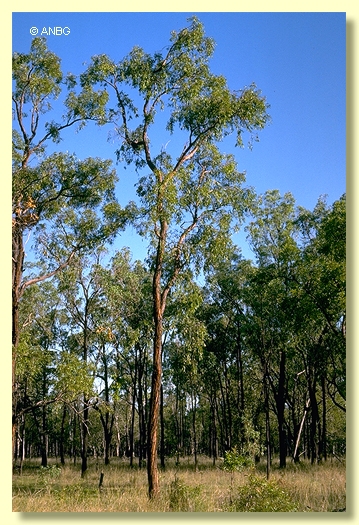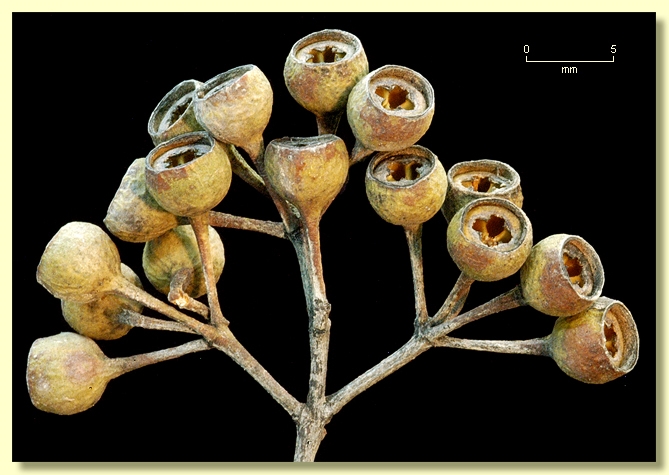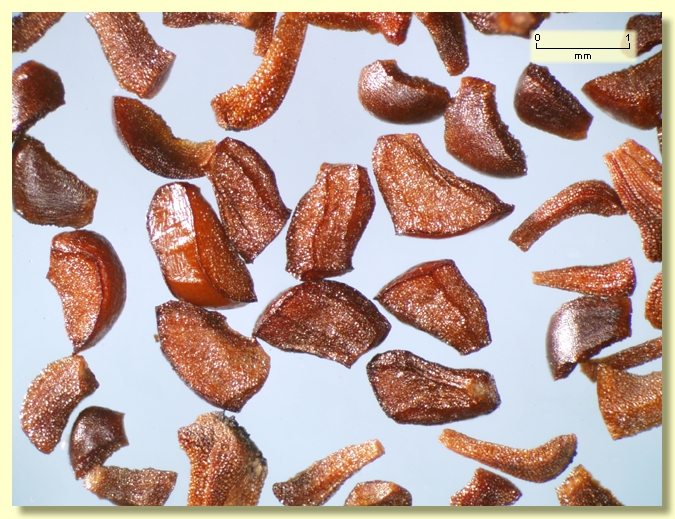Euclid - Online edition
Eucalyptus tenuipes
Eucalyptus | Cuboidea
Tree to 5 m. Forming a lignotuber.
Bark rough to small branches, fibrous, brown-grey, thick even on sapling growth, becoming fissured on larger stems.
Branchlets: lack pith glands; non-glaucous.
Juvenile growth (coppice or field seedlings to 50 cm): stem rounded to square in cross-section, smooth; juvenile leaves opposite, sessile or becoming shortly petiolate, linear to narrowly lanceolate, 7–15.5 cm long, 0.4–1.2 cm wide, base usually rounded, stem-clasping only on lowest leaves, apex pointed, discolorous, green.
Adult leaves always opposite (rarely a few leaf pairs subopposite), petiole 0.4–1.5 cm long; blade narrowly lanceolate or narrowly elliptical, (3.5)5–13.5 cm long, 0.8–2(2.8) cm wide, base tapering to petiole, margin entire, apex pointed, strikingly discolorous, dull, darker green above, side-veins greater than 45° to midrib, moderately to densely reticulate, intramarginal vein present and just within margin, oil glands few, island or none visible.
Inflorescence terminal and compound, axillary compound and sometimes single axillary umbels also below this, peduncles slender, (0.1)0.3–1.5 cm long, buds in umbels of ca 11–20 or more, pedicels (0.3)0.6–1.5 cm long. Mature buds globular to pyriform or ovoid, 0.3–0.4 cm long, 0.2–0.3 cm wide, rough with small warts, microscopic sepals present in young buds but deciduous or become obscured as bud enlarges, operculum scar absent, inner (petaline) operculum flattened to rounded, thin-textured with petal margins ± visible forming a cross, stamens regularly inflexed, anthers globoid, versatile, dorsifixed, dehiscing by separate longitudinal slits, style long, stigma tapered, locules 4 or 5 each with four vertical ovule rows or the rows obscure. Flowers white.
Fruit long-pedicellate (pedicels (0.3)0.6–1.5 cm long), truncate-globose to ± hemispherical, 0.3–0.7 cm long, 0.4–0.7 cm wide, (0.3)0.4–0.6 cm long, disc flat, level with rim or placed below it, valves 4 or 5, held at disc level.
Seeds glossy brown, 1–2 mm long, pyramidal to cuboid, dorsal surface smooth, hilum terminal.
Cultivated seedlings (measured at ca node 10): cotyledons reniform; stems rounded in cross-section, glabrous, non-glaucous; leaves sessile, opposite for many nodes, narrowly elliptical for ca 2 nodes then linear to linear-lanceolate widest at the base, 8.5–14 cm long, 0.4–2.3 cm wide, base amplexicaul, margin entire, apex pointed, discolorous, green.
Flowering has been recorded in January, March, May and July.
A small tree endemic to Queensland, occurring north from Chinchilla, Barakula State Forest, Bollon State Forest and Gurulmundie in the Darling Downs north through Injune and Mundubbera, Rolleston, Springsure and Clermont with sporadic occurrences further north and east, e.g. Narrien Range, Junee Tableland, Keriong Range to its most northerly occurrence north-east of Pentland in the Mount Stewart Range. Eucalyptus tenuipes prefers drier gently undulating to steeper slopes and ridge-tops with sandy to gravelly or skeletal soils. The species does not form large stands but occurs as a component of low open forest with ironbarks, spotted gums and native pine (Callitris). Eucalyptus tenuipes is characterised by the crown of opposite discolorous dull green lanceolate adult leaves, compound inflorescences, umbels with numerous buds, buds and fruit with long slender pedicels, thick brown-grey stringy bark over trunk and branches and linear juvenile leaves. These features, particularly the adult leaves and bark, distinguish it from all species with which it grows. Other stringy-fibrous barked species, e.g. the white mahoganies E. apothalassica, E. acmenoides, E. carnea, all have alternate leaves in the crown.
In the classification of Brooker (2000) Eucalyptus tenuipes has no close relatives and is placed in a solitary position in Eucalyptus subgenus Cuboidea. It is unusual because of its floral characteristics, viz. sepals present (not united into an outer operculum), petals united into an operculum but with petal margins still visible, stamens whorled, anthers globoid, ovules in ca four rows, and also seeds cuboid-pyramidal, adult leaves opposite, petiolate and discolorous, inflorescences compound with the umbels having numerous buds (>11), cotyledons reniform, seedlings glabrous.
Eucalyptus tenuipes: Latin tenui-, thin and pes, foot, referring to the slender pedicel or stalk of the bud.













